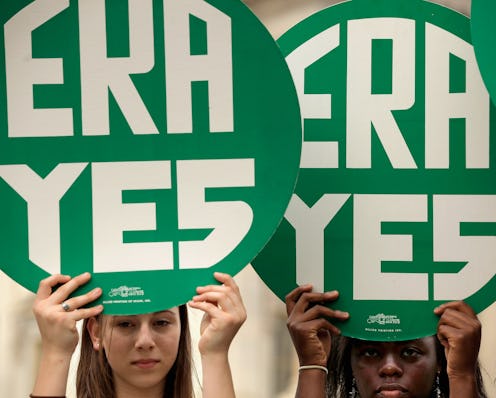Life
How To Argue For The Equal Rights Amendment

Here's a not-so-fun fact: 45 years after the Equal Rights Amendment prohibiting gender discrimination was passed, it still hasn't been ratified. You read that right — technically, gender equality isn't protected by the U.S. Constitution. Assuming you find that as alarming as I do, that means it's time to figure out how to argue for the ERA's ratification, so equal rights for all genders will finally be written into the framework of the country.
In 1923, three years after women were finally granted the right to vote, famed suffragist Alice Paul announced she had a new goal: passing an amendment (which she had already written in 1921) clearly stating that men and women deserve equal rights. Later that year, the ERA was introduced in Congress for the first time. Unfortunately, it certainly wasn't the last.
The ERA was met with opposition from the very beginning — first, from those concerned the amendment would negate special labor protections for women, and afterward, from social conservatives like Phyllis Schafly. Between 1923 and 1970, it was introduced and failed to pass in every session of Congress. It finally passed in 1972, but only 35 of the required 38 states ratified the amendment by the deadline in 1982.
Some states have passed their own versions of the ERA, but 15 years later, the ERA remains unratified on a national level. In recent years, though, the movement to ratify the ERA once and for all has gained steam once more. Here are common arguments against the ERA — and how to argue in its favor.
Common Argument #1: The ERA Takes Away Women's Protections
This was a common argument in the early stages of the ERA, but it still applies today. Some opponents claim that by guaranteeing that men and women hold the same legal rights, women are actually the ones who will suffer. For instance, unlike men, women are currently not required to register for the draft; passing the ERA might mean that women would have to sign up. However, this misses a huge point: Many of these "protections" are actually limitations. Although they're exempt from conscription, women in the military have struggled to be allowed to perform the same jobs as men — it wasn't until 2015 that all combat roles were opened to women.
On the flip side, the ERA could add a particular protection for women: protection against discrimination based on pregnancy.
Common Argument #2: The Equal Protection Clause Already Guarantees Women's Rights
Part of the 14th Amendment passed in 1868, the Equal Protection Clause requires states to treat all citizens equally under the law. It sounds like it should prohibit gender discrimination, but that's not always how it shakes out.
Under the EPC, an individual has to prove the intent to discriminate. As Cornell's Legal Information Institute explains, "If a law creates a disparate impact but this impact was not the purpose of the law, it will survive an equal protection challenge." Basically, discrimination isn't illegal if it's unintentional. If the Constitution explicitly prohibited discrimination based on gender, however, people could find recourse even if discrimination wasn't intentional — which it often isn't.
Common Argument #3: The ERA Will Lead To Single-Sex Bathrooms
In the '70s, a coalition of anti-ERA groups known as Operation Wake Up," claimed that passing the amendment would lead to mandatory shared bathrooms and same-sex marriage. I can only imagine their consternation had they known that same-sex marriage would be legalized just a few decades later, with or without the passage of the ERA, but the most relevant part here is the bathroom panic.
First, and most importantly, the ERA wouldn't require unisex bathrooms. As Timothy D. Shellhardt pointed out for the Wall Street Journal back in 1979, that's covered by citizens' right to privacy, which would protect gender-segregated dorms and locker rooms. Secondly, does anyone really believe that an amendment protecting gender equality would be grounds for men and women being forced to share bathrooms? Some ERA opponents might point to recent legislation in some states allowing transgender people to use the bathroom corresponding to their gender, but that still follows the same principle: People who identify as women use the women's bathroom, and people who identify as men use the men's bathroom. The only problem is when someone doesn't recognize transgender identities as valid. By the way, research has shown that fears about "transgender predators" assaulting people in bathrooms are completely, utterly unfounded.
Common Argument #4: States Can Draft Their Own Protections
It's true that states can draft their own protections against gender discrimination. Each state has its own constitution; that's why Colorado pot dispensaries sold more than $1 billion in marijuana last year when that kind of thing can get you arrested in other states. The problem is that historically, states haven't done a great job of passing equal protection amendments. Of the 50 states, only about 20 have adopted amendments similar to the ERA.
Common Argument #5: Women Are Already Equal
Women might be able to vote and run for president in the U.S., but that hardly means gender equality has been achieved. Women are still paid far less than men for the same amount of work, even when you account for factors like maternity leave. In fact, according to the American Association of University Women, the wage gap won't close until 2152 at this rate. Rape culture creates a society in which women are assaulted and abused at rates far higher than men, and harassment is an everyday reality for women in ways that it isn't for men. Anyone who says we've already achieved gender equality isn't paying attention.